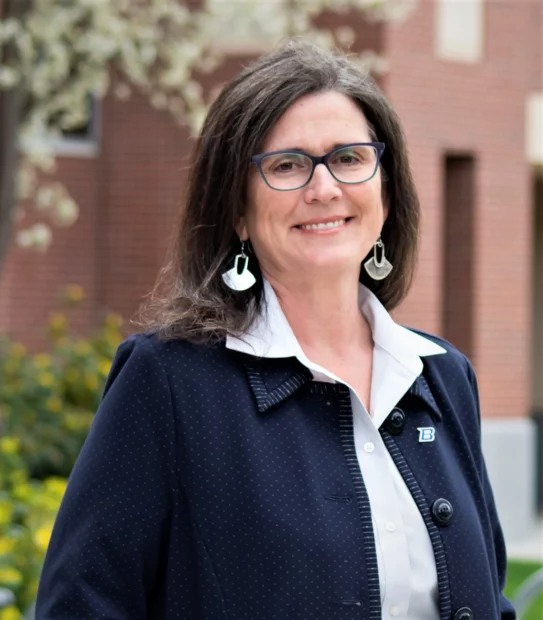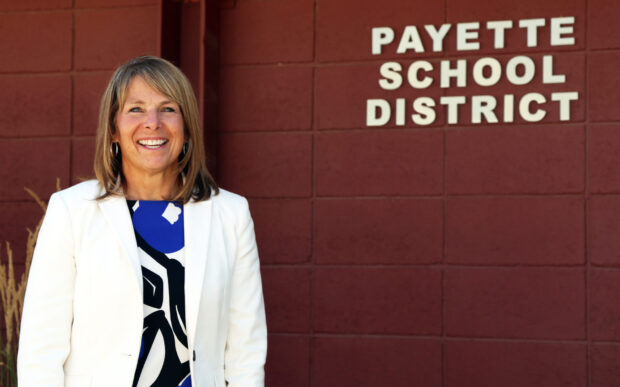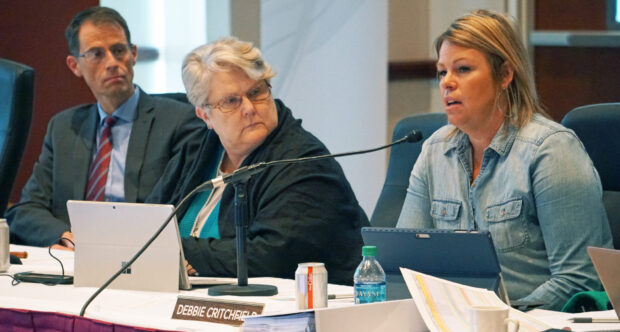Megan Christiansen is used to the doubters — people who are quick to undermine her or question whether a woman has the backbone to be a leader.
And she’s used to proving them wrong.
In July, Christiansen is set to become Teton School District’s first female superintendent, shattering a glass ceiling that’s been in place for over a century.
She’s part of a growing trend of more women taking on leadership roles in education after long being underrepresented.

While Idaho had its first female state superintendent back at the turn of the 20th century, women are still overcoming extra obstacles to step into leadership roles at the district level. They often have to work harder, be more credentialed, and face more criticism than their male peers.
Even so, more women are claiming seats at the table in Idaho and across the nation.
Getting there takes support from mentors, families, and communities — that, and an unflagging drive to reach new heights.
Here’s their story.
Nationwide, more women in education are becoming leaders — but they’re still underrepresented
Women are working their way into more leadership positions nationwide, but aren’t as well-positioned for promotions as their male counterparts.
That’s because while most principals across the country (56%) are now women, they are primarily in elementary school leadership positions.
Men, on the other hand, claim most secondary school leadership positions. And candidates for the top school leadership post — superintendent — are usually pulled from those middle and high school leadership ranks.
Men still outnumber women as secondary principals — jobs that are more likely to lead to superintendencies
| Public school level | % of male principals | % of female principals |
| All public schools | 44% | 56% |
| Elementary | 31.4% | 68.6% |
| Middle | 56.3% | 43.7% |
| Secondary | 64.5% | 35.5% |
| Combined/other | 48.2% | 51.8% |
*For school year 2020-2021; Source: National Center for Education Statistics (page 16 of this pdf)
But Heather Williams, a Boise State University professor, points out that “sexism cuts both ways.” While it can be harder for women to break into secondary or district leadership roles, it can also be harder for men to be seen as the best pick for an elementary principal.
Also worth noting: the vast majority of teachers across the country are women (77%) — a figure that’s held relatively steady since the ’80s.
What has changed is that today, women are twice as likely to be principals.
In the late ’80s, only a quarter of principals were women. In 2020-2021, that figure jumped to 56% — more than half.
It’s a marked increase. However, it still doesn’t mirror the teaching community. It begs the question: if 77% of teachers are women, why aren’t 77% of principals and superintendents women?
% of female principals has more than doubled over the past three decades
| School year | % of female public school principals | % of female public school teachers |
| 2020-2021 | 56% | 77% |
| 1987-1988 | 25% | 71% |
Source: National Center for Education Statistics
“It’s an interesting phenomenon,” Linda Clark, a former superintendent of the West Ada School District and the acting vice president of the State Board of Education, said. “That’s the question I think we’ve all scratched our heads and asked: why is it upside down at the upper echelons?”
In Idaho, for example, 42 of 133 superintendents or assistant superintendents are women — or about 32%.
In Idaho, 42 of 133 superintendents or assistant superintendents are women — or about 32%.
In addition to being underrepresented in leadership roles, women also tend to make less than their male counterparts, according to a 2018 report by the National Center for Education statistics.
“The average base teaching salary of female public school teachers is less than that of their male counterparts ($55,490 vs. $57,453),” the report reads. “Comparably, female public school principals also had a lower average salary in 2017–18 than did male principals ($96,300 vs. $100,600).”
In Idaho, a 2021 study found that the pay gap between male and female school administrators was not significant. However, women had to attain higher levels of education and work more days than men to get to the same place.
Women “have to work longer, harder, and smarter” as school administrators, Williams, who co-authored the study, told EdNews.
A check-in with today’s women in education leadership shows that still seems to hold true — women face more obstacles on the path to the top.
Sexist comments and heightened criticism litter a woman’s path to leadership
Williams, who leads Boise State’s executive educational leadership program, remembers the first time she encountered sexism.
It was in her first year as a superintendent at the Gooding School District, and she was catching some flak for a decision she’d made.
Then a community member told her: “This is the right decision. And if you were an older man, they would accept it without any problem.”
For Williams, who was born the same year Title IX became law, the revelation came as a shock.
“I thought I could do anything,” she said.

Women in Idaho’s education leadership often say they’ve faced similar incidences of sexism, but they’re reluctant to get into details. That’s partly because it can be difficult to prove that sexism is happening, and because they see it as just part of their day-to-day norm — something more worth shrugging off than reliving.
“It’s just the reality we deal with in life,” Robin Gilbert, a professor at Northwest Nazarene University and the director of its educational leadership program, said.
She could quickly list off examples:
- Board or community members might favor men for leadership positions, and they may do so subconsciously.
- Women are more likely to be critiqued for their appearance or outfit.
- Women are more likely than men to underrate their abilities.
- Men tend to be more effective at negotiating contracts.
- Women may be more impacted by social expectations to prioritize motherhood and family over career.
Part of this knowledge comes from her experience, and part comes from her role at NNU, mentoring the next generation of trailblazers.
Gilbert often coaches her female students to adopt a competitive rather than humble voice, and to value their experience as much as a man would. And she explicitly teaches the women in her program to stop apologizing and peppering their job applications with limiting words — like that they’re “just” a first-grade teacher.

Being a superintendent is already difficult enough — but it’s even more so for women, Wilfred Cwikiel, a doctoral candidate and superintendent from Michigan, said.
Cwikiel is working with Williams on his dissertation: an exploration of rural superintendent longevity that’s required him to interview 14 rural superintendents — half from his state, and half from Idaho. Six of those were women, and they each had something to say about facing sexism or misogyny.
For one superintendent, it was being called “sweetie” or “honey” at board meetings. For another, it was being frequently doubted or belittled.
Cwikiel recognizes that, as a man, he doesn’t have to deal with those added burdens: “How wonderful would it be if my female counterparts didn’t have to have that additional psychological burden or stress in the back of their minds at every moment?”
But anecdotally, Williams and Gilbert are seeing more women join their programs with an eye on leadership positions. For those hopefuls, determination and mentorships have an outsized impact.
“Women need women mentors”: words of encouragement turn teachers into superintendents
Christiansen will never forget the high school literature teacher who recognized her potential.
Her name was Mrs. Schafer, and she took Christiansen and a few other students to meet Nebraska’s poet laureate. Christiansen got to share a poem of hers, and gained a newfound confidence in her writing skills.
“It made me realize I can do great things,” Christiansen said. “She knew that I was insecure, but she pushed me really hard and then she rewarded me in a way that I’ll never forget.”
Christiansen went on to become a teacher — following in her mother and grandmother’s footsteps — and then a female mentor’s words changed her life again.
This time, it was a principal Christiansen worked for in the Omaha Public School District. She encouraged Christiansen to go back to school and become a principal.
“Those little seeds that people plant in your brain make you feel like you can be more,” Christiansen said. “That’s why I’m here, really. And I hope I can do the same for the people in my buildings and in this district, as a leader.”
Williams agrees that those words of support can make all the difference: “Women need women mentors,” she said.
But she added male mentors are valuable, too, and the more diverse support systems a young leader has, the better.
Cwikiel’s study unveiled another critical factor to getting women in top education jobs: doggedness.
The female superintendents he interviewed were mission-driven and “developed a sense of self where they were undaunted by people calling them ‘sweetie’ or ‘honey’, or questioning their wisdom or their ability.”

Clark said she was lucky to have never experienced sexism as she became a leader.
But she agrees that support and mentorship are essential for up-and-coming superintendents.
Her journey upward started just like Christiansen’s — with a female principal forecasting her future: “You’re going to be a principal and the other lady principals and I are going to be your mentors.”
And so it was.
When Christiansen becomes a superintendent this summer, she hopes to return the support she’s gotten by blazing the trail for others, including students.
“I want all children to follow their hearts and become whatever it is that makes them happy and brings them joy in life,” Christiansen said. “Being a female role model in our school district — I hope that resonates with all students.”
Data analyst Randy Schrader contributed to this report.
